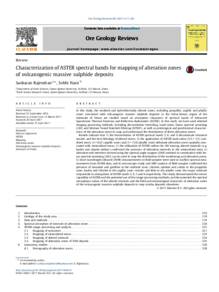Document
Recognition of minerals using multispectral remote sensing data : a case study in the Sultanate of Oman.
Identifier
https://doi.org/10.24200/squjs.vol19iss2pp37-52
Source
Sultan Qaboos University Journal for Science. v. 19, no. 2, p. 37-52.
Contributors
Nasir, Sobhi., Author
Country
Oman.
City
Muscat.
Publisher
College of Science, Sultan Qaboos University.
Gregorian
2014
Language
English.
English abstract
The present study demonstrates the capability of a multispectral sensor for the detection of the minerals in the rocks surrounding the Rusayl and Al Jafnayn regions, Sultanate of Oman. The study of spectral absorptions of rocks and minerals in the visible and near infrared (VNIR) and short wavelength infrared (SWIR) spectral bands of the Advanced Spaceborne Thermal Emission and Reflection Radiometer (ASTER) using the Spectral Angle Mapper (SAM) supervised image classification technique has provided information on the occurrence of minerals in the rock types of the regions. The study shows the occurrence of carbonate minerals in the limestone formations and of poorly altered silicate minerals in the basic dyke rocks of the study regions. The analysis of minerals over the ancient terraces and recent alluvial deposits show that the deposit materials are derived from the dykes and foliated gabbro source rocks. The image interpretation is compared to the geological map, verified in the field and confirmed through laboratory analyses. The satellite data and the image processing techniques used have potential in the recognition of minerals in the rocks of the study region and could be used in similar arid regions elsewhere in the world.
ISSN
2414-536 X
Arabic abstract
تُظهر هذه الدراسة قدرة مُستشعر متعدد الأطياف على كشف المعادن في الصخور المحيطة بمنطقتي الرسيل والجفنين، سلطنة عُمان. وقد وفّرت دراسة الامتصاصات الطيفية للصخور والمعادن في النطاقات الطيفية المرئية والقريبة من الأشعة تحت الحمراء (VNIR) والأشعة تحت الحمراء قصيرة الموجة (SWIR) لجهاز قياس الإشعاع الحراري الفضائي المتقدم (ASTER) باستخدام تقنية تصنيف الصور المُشرفة لجهاز رسم الزوايا الطيفية (SAM) معلوماتٍ عن وجود المعادن في أنواع الصخور في المنطقتين. وتُظهر الدراسة وجود معادن الكربونات في تكوينات الحجر الجيري ومعادن السيليكات قليلة التغير في صخور السدود القاعدية في مناطق الدراسة. ويُظهر تحليل المعادن فوق المدرجات القديمة والرواسب الرسوبية الحديثة أن مواد الرواسب مُشتقة من السدود وصخور الجابرو المُورقة. ويُقارن تفسير الصورة بالخريطة الجيولوجية، ويُتحقق منه ميدانيًا ويُؤكده من خلال التحليلات المخبرية. تتمتع بيانات الأقمار الصناعية وتقنيات معالجة الصور المستخدمة بإمكانيات كبيرة في التعرف على المعادن الموجودة في صخور منطقة الدراسة ويمكن استخدامها في مناطق قاحلة مماثلة في أماكن أخرى من العالم.
Category
Journal articles



